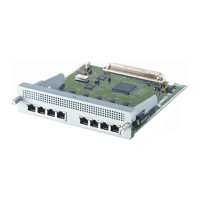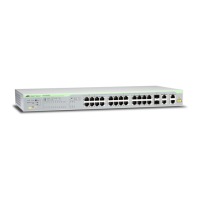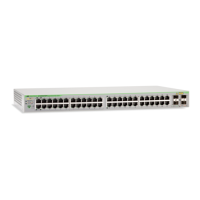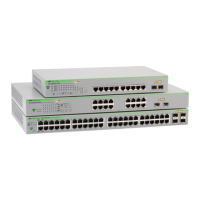Introduction Dual Ring Configuration
Software Reference for SwitchBlade x3100 Series Switches (Layer Two Switching)
4-120
low the Polling Fault Detection procedure and, since the fault is no longer present, the EPSR domain continues
to remain in the complete state
The network topology, restored to its normally operating state, continues to operate until a fault is detected,
when, again, the above mentioned procedures are re-executed. EPSR maintains a continuous, uninterrupted
operation of the user’s network.
4.6.4.6 Transit Node Fault Restoration Procedure
The transit node(s) that span the faulty link will delay the starting of the flow of non-control traffic over the link
once the fault has been fixed and the link restored. The reason for this delay is to prevent the master node
from viewing the fixed link as a loop in the network. The loop is caused because the transit node has corrected
the fault for the domain before the master node detects that the fault is restored and blocks its SP port for the
domain non-control traffic. In order to avoid this situation, the transit node(s), after detecting that the broken
link has been restored, follow these fault restoration procedures:
1. Ensure that the protected vlans are still in a blocked state for the repaired port. The state of the restored
port was set as blocked earlier when the state of the domain went from Links-Up to Links-Down
2. Change the state of the EPSR domain from Links-Down to Pre-forwarding
3. Wait for the EPSR Ring-Up-Flush-FDB control message from the master node. This is the trigger that
ensures that the master node has detected the restoration of the fault in the ring, flushed its FDB, and
blocked its SP port for the domain non-control traffic.
4. Flush its FDB, for both the ring ports, upon receiving the above trigger message from the master node
5. Change the state of the EPSR domain from Pre-Forwarding to Links-Up when the flow of the domain
non-control traffic can start to flow again ensuring that there is no loop present in the ring. At this point,
the state of the port is set to Forwarding.
4.6.5 Dual Ring Configuration
The discussion above had an underlying assumption that there is an Ethernet ring access network consisting of
Allied Telesis systems that are physically connected to form a ring using EPSR functionality to provide redun-
dancy at the layer 2 level. The master node in this EPSR-enabled ring network is the one which is considered to
be the layer 2 aggregating switch with an uplink to the core. However, there could be a case where the access
network consists of multiple rings, interconnected to form a more complex access network with uplinks to
the core network. An example of such a network is shown in Figure 4-11.
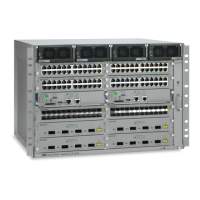
